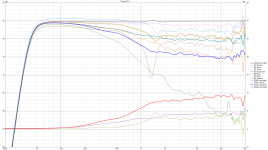Modeling in VituixCAD was surprised to learn a large bump in horizontal polars improved the power and DI curves (and preference score). Apparently, the reflections make up for vertical polars in the crossover bandwidth. I had assumed better controlled horizontals always improved speaker performance. Would you trade better horizontal polars (Model 2) away to obtain better power + DI curves but worse horizontals (Model 1)?
Model 1: LR48-1350/1450, Preference score 7.498

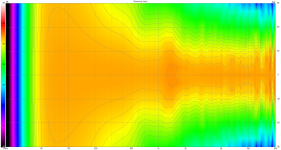
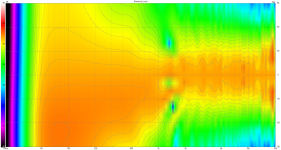
Model 2: LR48-1400/1475, Preference score 7.446
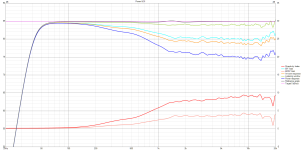
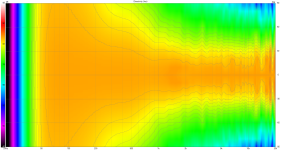
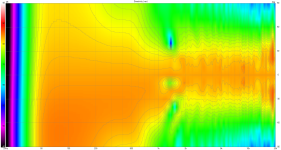
Model 1: LR48-1350/1450, Preference score 7.498



Model 2: LR48-1400/1475, Preference score 7.446



No I wouldn’t. This way, the horizontal, the vertical and the direct could each sound distinct, even though a diffuse reverberant field might be better balanced.
Obviously, each speaker in each room is a different story and you should analyse this situation independently.
Obviously, each speaker in each room is a different story and you should analyse this situation independently.
I think it might be more useful to break out the side, ceiling, and floor reflections, rather than looking just at global DI.
My guess it that you would have a difficult time trying to distinguish these version by ears only. And even if you did hear a difference, I doubt that either would sound necessarily "better". Preference score to two decimal places is really not something to chase after 🙂
- I'm so much looking forward to your ON/DI experiment!
- I'm so much looking forward to your ON/DI experiment!
If there is a preference score then presumably the perfect directivity with a score of 10 must be known? Can someone please post what it is?
^^ Yeah, both very good. Which works better is task for listening after you've set it all up. You likely do not hear any single reflection, but "quality" of stereo sound and perhaps coloration from all combined. Perhaps it is possible to hear difference with vertical and horizontal response like AllenB suggests.
Early reflections are the loudest of all and dealing with them depends on if you like to listen far away for big hazy sound or close enough with better clarity and to hear spatial stuff in the recording. If you like the big hazy sound you probably want to leave loud side wall early reflections to "enhance" the sound, but if you like the close sound you probably want to reduce all early reflections as low in level as possible in order to have more of late reflections in relation to get the bigness that way. Some coloration due to early reflections is probably heard on both, like big suck out on low mids. Perhaps some early reflections like that from the ceiling and front wall would always benefit from care.
So, it all can be optimized only for your particular need, room, listening setup. So, the responsibility is for you to figure out what you like, then how to achieve that in your room, what the listening setup placement can be and how to make the speakers and acoustics to enable it.
ps. You can affect the lines with speaker elevation, tilt and rotation as well 😉
pps. the preference score is fun, but not very helpful on any of this since it does not include your mind, your room, SPL capability / dynamics, temporal stuff in general, your placement nor knowledge of measurement errors and so on 😉 Its just an average and useful as such but do not put too much weight on it.
Early reflections are the loudest of all and dealing with them depends on if you like to listen far away for big hazy sound or close enough with better clarity and to hear spatial stuff in the recording. If you like the big hazy sound you probably want to leave loud side wall early reflections to "enhance" the sound, but if you like the close sound you probably want to reduce all early reflections as low in level as possible in order to have more of late reflections in relation to get the bigness that way. Some coloration due to early reflections is probably heard on both, like big suck out on low mids. Perhaps some early reflections like that from the ceiling and front wall would always benefit from care.
So, it all can be optimized only for your particular need, room, listening setup. So, the responsibility is for you to figure out what you like, then how to achieve that in your room, what the listening setup placement can be and how to make the speakers and acoustics to enable it.
ps. You can affect the lines with speaker elevation, tilt and rotation as well 😉
pps. the preference score is fun, but not very helpful on any of this since it does not include your mind, your room, SPL capability / dynamics, temporal stuff in general, your placement nor knowledge of measurement errors and so on 😉 Its just an average and useful as such but do not put too much weight on it.
Last edited:
Depends on which formula you use to calculate the number 😉If there is a preference score then presumably the perfect directivity with a score of 10 must be known? Can someone please post what it is?
Here formulas available in VituixCAD and what the score is for ideal point source.
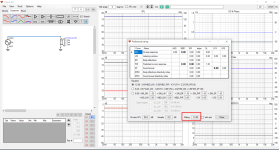
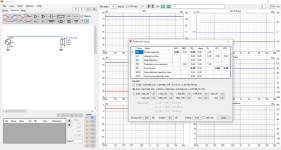
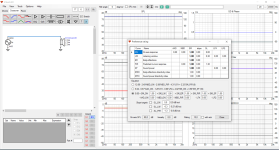
https://kimmosaunisto.net/Software/VituixCAD/VituixCAD_help_20.html#Preference_rating
Depends on which formula you use to calculate the number 😉
So there are multiple different perfect directivities. That makes much more sense. I hope it is only the US that support such patents. The patent system has progressively become pretty seriously broken in recent decades.
Here formulas available in VituixCAD and what the score is for ideal point source.
Do people that consider such preference scores to be of significance read and understand such information?
Despite the preference scores VituixCAD seems to be becoming a useful bit of software. I don't use Windows for work but I do now have a small portable with Windows as an option for notes and carrying around (most linux software does not support a touch screen well enough to be usable). I will make an effort. Soon. Probably.
Oh for sure, VituixCAD is very very useful tool.
What was the old saying, "good thing about standards is that there is many" 🙂 Just pick the most suitable one 🙂
Preference score is good for marketing people, make it bigger than others using what ever means. Get pole position in a ranking list and sell more. But it can be useful for DIY folks as well; one could try and optimize filters for a good known target (slope), or quickly look at some curve smoothness and so on, another indicator amongst others. But, almost meaningless unless one knows how it should sound like and how the graphs relate to perceived sound and what is the measurement accuracy. Meaningless in a sense that worse number could sound better to ear if tuning blindly. If one knows how the system should be setup and then uses the number to further smoothen things up, it could be meaningful.
What was the old saying, "good thing about standards is that there is many" 🙂 Just pick the most suitable one 🙂
Preference score is good for marketing people, make it bigger than others using what ever means. Get pole position in a ranking list and sell more. But it can be useful for DIY folks as well; one could try and optimize filters for a good known target (slope), or quickly look at some curve smoothness and so on, another indicator amongst others. But, almost meaningless unless one knows how it should sound like and how the graphs relate to perceived sound and what is the measurement accuracy. Meaningless in a sense that worse number could sound better to ear if tuning blindly. If one knows how the system should be setup and then uses the number to further smoothen things up, it could be meaningful.
That's what the preference score is supposed to predict, right? Let's not dismiss the science and all the effort behind it, it was not a small achievement....unless one knows how it should sound like and how the graphs relate to perceived sound
- The better the score among several versions, undoubtedly the less discriminating (the less reliable) it becomes, but that's just how it works, I guess.
For a loudspeaker to have a high preference score means that there's a pretty high chance it would be ranked high in a blind test (at least under those conditions of the original tests), nothing more, but also nothing less.
Last edited:
Yeah I can understand that, thats the effort and best one can do for single number I guess, average sound for average room for average preference. Some people prefer different things with sound though, and listen in various rooms with various positioning. For example kimmosto has been against the rating because it is too coarse, that's why the third formula appeared to at least allow tuning some of the parameters like slopes to make it more useful. Still its missing effect of group delay / xo points basically, which to him is very important aspect of sound, sense of dynamics which is easily ruined by low / steep xo.
To me, why not, its a nice way to kind of know where the system is at related to other systems in general. Still, it is worth it to experiment with things regardless of the number.
To me, why not, its a nice way to kind of know where the system is at related to other systems in general. Still, it is worth it to experiment with things regardless of the number.
The "group delay aspect" (i.e. a phase distortion), was never found to be an important issue, if an issue at all, to subjective loudspeaker assessment. People have simply hard time to be able to hear these things, unless it's extreme. It appears mentioned now and then as something that is supposedly overlooked and important, but all the evidence says it's really not when actually tested. Probably the most significant effect it can have is the subjective sense of distance but it's hardly something you would be able to tell without a direct comparison.
That's what the preference score is supposed to predict, right? Let's not dismiss the science and all the effort behind it, it was not a small achievement.
I think one needs to be careful to recognise the softness of the science and to handle it accordingly. This is not a criticism of the work which has likely proved useful for development purposes in Harman and possibly elsewhere.
For a loudspeaker to have a high preference score means that there's a pretty high chance it would be ranked high in a blind test (at least under those conditions of the original tests), nothing more, but also nothing less.
But is it used in this way? A brief perusal of ASR would suggest perhaps not for a fair few who are working to the metric and forgetting or likely never understanding what it actually represents.
(I have of course supported in an adjacent thread using 1% and 3% THD distortion as a useful practical way to bound the clean SPL region for a speaker. This requires an understanding of what THD actually is rather than using it as direct measure of subjective badness which a fair few seem to assign to it. So perhaps I can't have it both ways?)
Yeah it is a mixed bag, I think there is hint in the Griesinger studies on this, what to listen for. I've just posted about it in ATH thread, mostly just interpretation and speculation by me though 🙂The "group delay aspect" (i.e. a phase distortion), was never found to be an important issue, if an issue at all, to subjective loudspeaker assessment. People have simply hard time to be able to hear these things, unless it's extreme. It appears mentioned now and then as something that is supposedly overlooked and important, but all the evidence says it's really not when actually tested.
...
Think this; what if a study for audibility of group delay was performed listening too far, speaker was too far so that phase is already mingled by the room reflections and it doesn't matter what the group delay was? This I've noticed by adjusting tweeter delay sitting other side of the room aside my DSP rack; to my surprise there was no difference what so ever (other than some effect in frequency response), until distinct separate sound happens. Putting together Griesinger studies and phenomena I've observed I speculate that phase errors like group delay are audible when listening close enough so that direct to reverberant sound ratio is high enough. It might just move distance of the transition between the two. According to Griesinger, difference being at close proximity or too far is basically phase error, when brain cannot make sense of harmonics of the sounds you are too far, reflections are too loud. I've yet to test the tweeter delay trick on the close listening distance 🙂
Exactly, listening too far harmonic information mingled by room sound, the stereo sound appears quite 2D and between speakers with my setup. Listening close enough there is depth and 3D aspect to stereo sound, some of the spatial stuff on the recording comes through while the local environment seems to more or less disappear acoustically. Direct comparison is possible, transition between the two stages seem to happen around 2.2m listening distance with my setup so its very interesting phenomenon to me, I can switch the perspective with one step. Even more interestingly it seems to be just about direct / reverberant ratio, and not about some single aspect like horizontal or vertical reflections and stuff like that. I've got small O110 studio monitors to compare and the transition distance is about the same as with slightly higher DI main setup with ST260 waveguide and cardioid mid. Hifijim recently posted on his thread that there was quite big difference in this distance with two pair of speakers he has.... Probably the most significant effect it can have is the subjective sense of distance but it's hardly something you would be able to tell without a direct comparison.
Aside from that, kimmosto has written few times how its not necessarily hearing system that hears the difference, but for example skin sensing dynamics and highly regards this sensation to point to say effect of group delay definitely matters, to him. I do not know if he listens at the close or far, perhaps both. Nobody seems to refer to the effect of listening distance, which to me seems paramount contextual information in order to understand and relate written words to perceived sound.
Last edited:
It is very interesting thing to speculate on 😀 like Geddes study seems to be done on headphones, what if you try same test with speakers while listening at the far distance, phases already mingled beyond brain ability to lock in? Perhaps there is still audible difference like in the study, perhaps not. Certainly my speakers sound bad too loud, but I don't know what aspects make it so. It might be due to diffraction, group delay or ears distorting, perhaps my amplifier, most likely multiple things. The speakers certainly shouldn't have much THD at all, pro drivers with plenty of headroom left according to spec sheet, enough ways to prevent some IMD and so on. Just speculating 🙂
Last edited:
My experience with speakers having variously different DI curves is that a smooth DI and power response matters up to a point. The power response should smoothly decrease with frequency, and the DI curve (by definition) should smoothly rise with frequency. However, once the power and DI curves are within +/- 2 dB of being "smooth", any further refinement does not seem to make much difference to me... or to be more precise, I may be able to hear a very small difference, but I can't say that I prefer one curve over another.Would you trade better horizontal polars (Model 2) away to obtain better power + DI curves but worse horizontals (Model 1)?
I agree that the preference score is sometimes (often?) overemphasized. A score of 6 versus 8 certainly means something significant, and most people will prefer the 8. A score of 7.3 versus 7.6 probably does not mean much, and both scores should just be rounded to "7.5", and we should just conclude that both speakers have the same score, to within the limits of the tool. But some people think the score has 3-digit accuracy, which is silly.But is it used in this way? A brief perusal of ASR would suggest perhaps not for a fair few who are working to the metric and forgetting or likely never understanding what it actually represents.
Probably the best one-sentence synopsis of the true value and meaning of the preference score.For a loudspeaker to have a high preference score means that there's a pretty high chance it would be ranked high in a blind test (at least under those conditions of the original tests), nothing more, but also nothing less.
j.
Doesn't yours? it is quite common for me, on a proper movie theater for example, gun shots are too loud. On some gigs when an ear plug comes a bit loose ear distorts, nasty sound. Put it back in and sound is fine, speakers not distorting but my ears. I can crank it quite loud at home as well, essentially PA speaker although not that much amp power available, If sensitivity is around 90db/W/1m meter, its only few more watts to have that on listening spot + peaks. 90db (a weighted meter) is loud. Speakers should be well capable of that, amps perhaps distort, and perhaps hearing system either distorts or hears linear distortion on the system like Geddes suggest. Bad sound nevertheless.
Last edited:
- Home
- Loudspeakers
- Multi-Way
- Worse Horizontal = Better Power + DI

